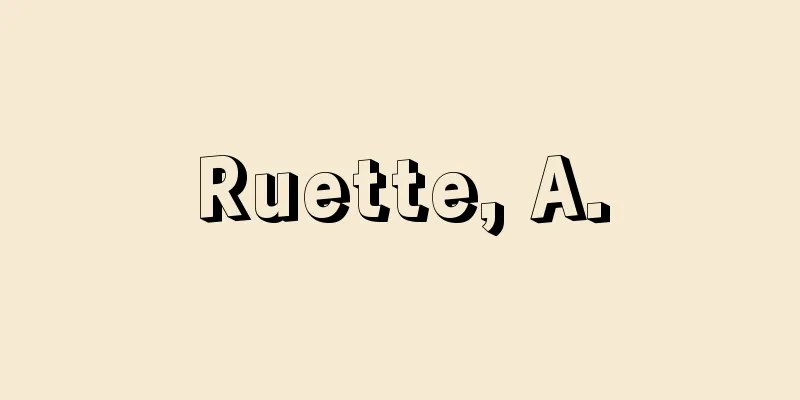House fly - Iebae (English spelling)

|
An insect belonging to the family Muscidae, suborder Cyclorrhaphy, class Insecta, order Diptera. It is the most common fly found in human environments around the world, with a body length of 4 to 8 millimeters. The compound eyes are far apart in both sexes, but in males they are slightly narrower. There are four black vertical stripes on the thorax, and the second and third abdominal segments are yellow. It is easily distinguished from other species in the genus Musca by the hairs on the pronotum. There are geographical individual variations in the width of the compound eyes and the abdominal markings in males; in cold regions the compound eyes are wider and the body color is black. Based on these variations and differences in the development of characteristics for living in human environments, it is subdivided into the following five subspecies. In addition to M. domestica calleva and M. domestica curviforceps found in Africa, M. domestica domestica found in Europe, and M. domestica nebro found in India, the most highly pest species , M. domestica vicina , is found in cities and rural areas around the world, including Japan. Japanese houseflies have a tendency to invade and live inside houses, lay eggs, and their larvae (maggots) emerge from livestock droppings and garbage dumps. They can occur in large numbers at garbage disposal sites in cities (such as Yumenoshima Island in Tokyo Bay), and at pig and chicken farms in rural and suburban areas, often becoming a social problem. Adults can be found from early spring to late autumn, and are active even in winter in warm places. It takes about 10 days for eggs to develop into adults. Many species of Musca flies are found mainly in Eurasia, but all of them originate from animal feces. Adults of M. conducens and M. hervei feed on the eyes and wounds of livestock, licking their tears and blood and transmitting livestock diseases. M. sorbens is common in tropical regions of Africa and Asia, where its larvae develop in human feces, and its adults frequently feed on the eyes, noses, mouths, and wounds of both humans and livestock, transmitting eye diseases such as trachoma to humans. [Hiroshi Kurahashi] [Reference] |©Tatsuo Ikeda ©Kenzo Otawa ©Kei Daishoji "> Major types of flies (1) Buccal group - petals-winged… Source: Shogakukan Encyclopedia Nipponica About Encyclopedia Nipponica Information | Legend |
|
昆虫綱双翅(そうし)目環縫亜目イエバエ科に属する昆虫。世界中の人間生活の環境にもっとも普通にみられるハエで、体長4~8ミリメートル。複眼は雌雄とも離れているが、雄はその幅がやや狭い。胸背に4本の黒色の縦条があり、腹部第2、第3節は黄色である。前胸側板に毛が生えていることにより、イエバエ属の他種から容易に区別される。雄の複眼間の幅と腹部の斑紋(はんもん)には地理的な個体変異があり、寒い地方では複眼の幅が広く、体色が黒色を帯びる。これらの変異や、人間生活の環境で生活する性質の発達の違いから、次の五つの亜種に細分類される。アフリカに分布するM. domestica calleva、M. domestica curviforcepsやヨーロッパに分布するM. domestica domesticaやインドに分布するM. domestica nebroのほか、日本を含む世界中の都市や農村には、もっとも高度に害虫化したM. domestica vicinaが分布している。 日本のイエバエは、家屋内に侵入して生活する性質が強く、産卵性で、幼虫(ウジ)は家畜の糞(ふん)やごみためなどから発生する。都市ではごみ処理場(たとえば東京湾の夢の島など)や農村や郊外の養豚場や養鶏場などで大発生し、しばしば社会問題となることがある。成虫は早春から晩秋までみられ、冬でも暖かい場所では活動がみられる。卵から成虫までの発育日数は約10日である。 イエバエ属Muscaのハエは、ユーラシア大陸を中心に多くの種がみられるが、いずれも動物の糞を発生源としている。ウスイロイエバエM. conducensやノイエバエM. herveiの成虫は家畜の目や傷口にたかり、涙や血液をなめて家畜の病気を媒介する。フタスジイエバエM. sorbensは、アフリカやアジアの熱帯地域に多く、幼虫は人糞に発生し、成虫はヒトや家畜の目や鼻、口、傷口などに頻繁にたかり、ヒトにはトラコーマなどの眼病を媒介する。 [倉橋 弘] [参照項目] |©池田達夫 ©大多和鐘三 ©大聖寺慶"> ハエのおもな種類(1)有額嚢群―有弁翅… 出典 小学館 日本大百科全書(ニッポニカ)日本大百科全書(ニッポニカ)について 情報 | 凡例 |
>>: Light of the House - Ienohikari
Recommend
Oligarchy - Katousei
Rule by a minority. Also called oligarchy. Plato ...
Shell bucket - Kaioke
〘Noun〙 A bucket for holding shells in Kaiawase. A ...
Cheddar cheese
…The maturation period is 3 to 5 months. (5) Ched...
Saint-Just (English spelling) Louis Antoine de Saint-Just
1767‐94 He was a member of the National Assembly d...
Mount Togakushi
A mountain in the Togakushi district of Nagano Ci...
Gakusou - Gakusou
...He was at the center of the so-called San'...
Housemaid - Okujochu
During the Edo period, these were maids who serve...
Laminaria longissima (English spelling) Laminarialongissima
…[Yoshiharu Iijima]. … *Some of the terminology t...
Abuda - Abuda
… Next are the Eight Cold Hells: (1) Abuda, (2) N...
Relevance
…Evidence used to prove indirect facts is called ...
Grass and shellfish harvesting industry
A small-scale fishery targeting seaweed and shellf...
Tertullianus (English spelling) Quintus Septimius Florens Tertullianus
A Christian apologist from the 2nd and 3rd centur...
Thorn forest - Togerin (English spelling)
When the species that make up a forest are predomi...
Yayoi [town] - Yayoi
A former town in Minamiamabe County, southeastern ...
Goodwin, JF (English spelling) GoodwinJF
...In Japan, this disease is attracting attention...









